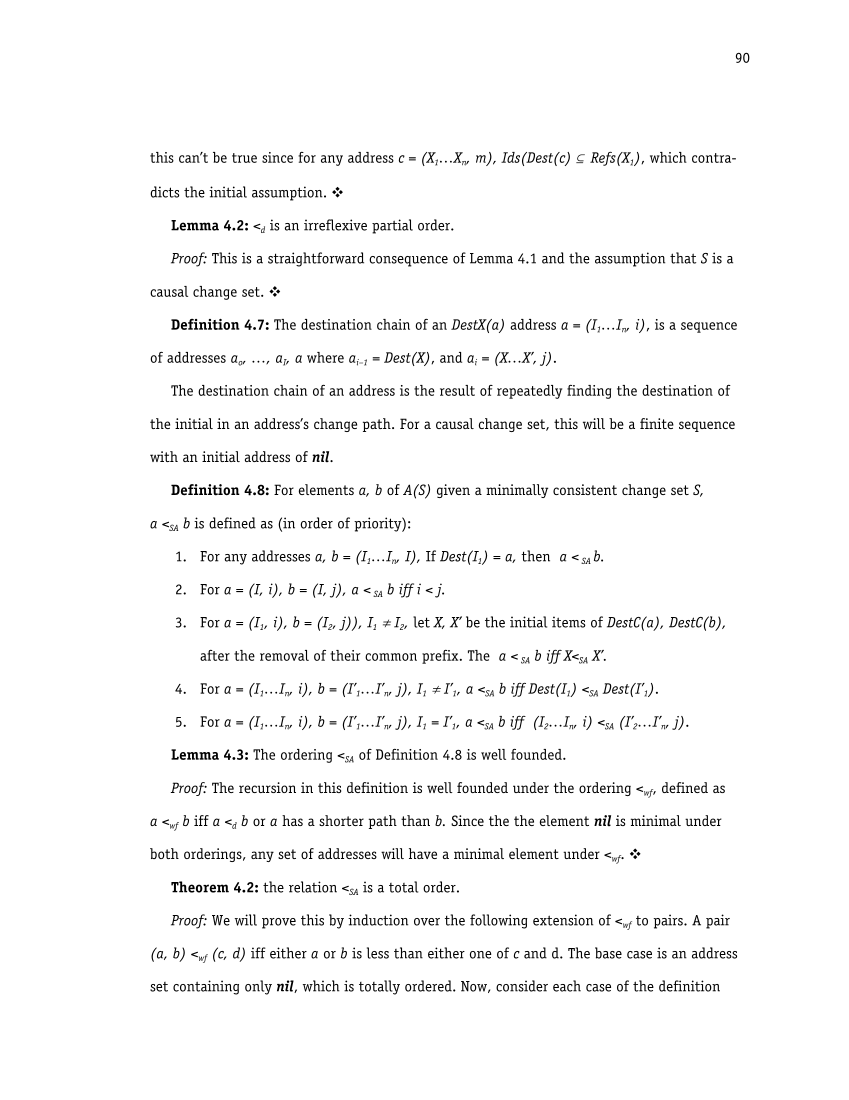90
this�can’t�be�true�since�for�any�address c�=�(X
1 …X
n ,�m),Ids(Dest(c) ˝ Refs(X
1 ),�which�contra-
dicts�the�initial�assumption. v
Lemma�4.2:<
d is�an�irreflexive�partial�order.
Proof:This�is�a�straightforward�consequence�ofLemma�4.1�and�the�assumption�thatSis�a
causal�change�set. v
Definition�4.7:The�destination�chain�of�anDestX(a)addressa = (I
1 …I
n ,�i),�is�a�sequence
of�addressesa
o , …, a
I ,�awherea
i–1 = Dest(X)
,�and�a
i = (X…X’,�j)
.
The�destination�chain�of�an�address�is�the�result�of�repeatedly�finding�the�destination�of
the�initial�in�an�address’s�change�path.�For�a�causal�change�set,�this�will�be�a�finite�sequence
with�an�initial�address�of�nil.
Definition�4.8:For�elementsa,�bofA(S)given�a�minimally�consistent�change�setS,
a <
SA bis�defined�as�(in�order�of�priority):
1. For�any�addressesa,�b = (I
1 …I
n ,�I),�IfDest(I
1 )�=�a,thena�<
SA b.
2. Fora = (I,�i),�b = (I,�j),�a <
SA b�iff�i <�j.
3. Fora = (I
1 ,�i),�b = (I
2 ,�j)),�I
1 „ I
2 ,�letX,�X’ be�the�initial�items�of�DestC(a),�DestC(b),
after�the�removal�of�their�common�prefix.�The�a <
SA b�iff�X<
SA X’.
4. Fora = (I
1 …I
n ,�i),�b = (I’
1 …I’
n ,�j),�I
1 „ I’
1 ,�a <
SA b�iff�Dest(I
1 ) <
SA Dest(I’
1 ).
5. Fora = (I
1 …I
n ,�i),�b = (I’
1 …I’
n ,�j),�I
1 = I’
1 ,�a <
SA b�iff (I
2 …I
n ,�i) <
SA (I’
2 …I’
n ,�j).
Lemma�4.3:The�ordering<
SA of�Definition4.8�is�well�founded.
Proof:The�recursion�in�this�definition�is�well�founded�under�the�ordering<
wf ,�defined�as
a <
wf biffa <
d borahas�a�shorter�path�thanb.Since�the�the�elementnilis�minimal�under
both�orderings,�any�set�of�addresses�will�have�a�minimal�element�under�<
wf .�v
Theorem�4.2:the�relation<
SA is�a�total�order.
Proof:We�will�prove�this�by�induction�over�the�following�extension�of<
wf to�pairs.�A�pair
(a, b) <
wf (c, d)iff�eitheraorbis�less�than�either�one�ofcand�d.�The�base�case�is�an�address
set�containing�only�nil,�which�is�totally�ordered.�Now,�consider�each�case�of�the�definition
this�can’t�be�true�since�for�any�address c�=�(X
1 …X
n ,�m),Ids(Dest(c) ˝ Refs(X
1 ),�which�contra-
dicts�the�initial�assumption. v
Lemma�4.2:<
d is�an�irreflexive�partial�order.
Proof:This�is�a�straightforward�consequence�ofLemma�4.1�and�the�assumption�thatSis�a
causal�change�set. v
Definition�4.7:The�destination�chain�of�anDestX(a)addressa = (I
1 …I
n ,�i),�is�a�sequence
of�addressesa
o , …, a
I ,�awherea
i–1 = Dest(X)
,�and�a
i = (X…X’,�j)
.
The�destination�chain�of�an�address�is�the�result�of�repeatedly�finding�the�destination�of
the�initial�in�an�address’s�change�path.�For�a�causal�change�set,�this�will�be�a�finite�sequence
with�an�initial�address�of�nil.
Definition�4.8:For�elementsa,�bofA(S)given�a�minimally�consistent�change�setS,
a <
SA bis�defined�as�(in�order�of�priority):
1. For�any�addressesa,�b = (I
1 …I
n ,�I),�IfDest(I
1 )�=�a,thena�<
SA b.
2. Fora = (I,�i),�b = (I,�j),�a <
SA b�iff�i <�j.
3. Fora = (I
1 ,�i),�b = (I
2 ,�j)),�I
1 „ I
2 ,�letX,�X’ be�the�initial�items�of�DestC(a),�DestC(b),
after�the�removal�of�their�common�prefix.�The�a <
SA b�iff�X<
SA X’.
4. Fora = (I
1 …I
n ,�i),�b = (I’
1 …I’
n ,�j),�I
1 „ I’
1 ,�a <
SA b�iff�Dest(I
1 ) <
SA Dest(I’
1 ).
5. Fora = (I
1 …I
n ,�i),�b = (I’
1 …I’
n ,�j),�I
1 = I’
1 ,�a <
SA b�iff (I
2 …I
n ,�i) <
SA (I’
2 …I’
n ,�j).
Lemma�4.3:The�ordering<
SA of�Definition4.8�is�well�founded.
Proof:The�recursion�in�this�definition�is�well�founded�under�the�ordering<
wf ,�defined�as
a <
wf biffa <
d borahas�a�shorter�path�thanb.Since�the�the�elementnilis�minimal�under
both�orderings,�any�set�of�addresses�will�have�a�minimal�element�under�<
wf .�v
Theorem�4.2:the�relation<
SA is�a�total�order.
Proof:We�will�prove�this�by�induction�over�the�following�extension�of<
wf to�pairs.�A�pair
(a, b) <
wf (c, d)iff�eitheraorbis�less�than�either�one�ofcand�d.�The�base�case�is�an�address
set�containing�only�nil,�which�is�totally�ordered.�Now,�consider�each�case�of�the�definition





























































































































































































